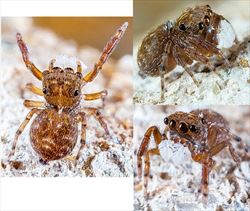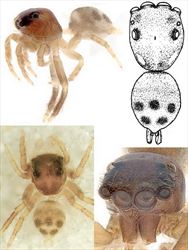
Examples of live Frewena sp.
Illustrator (and ©) R. Whyte

Aspects of the general morphology of Frewena maculata
Illustrator (and ©) B.J. Richardson (CSIRO, MP)

Palp morphology of Frewena n. sp (L). and Frewena maculata
Illustrator (and ©) B.J. Richardson (CSIRO, MP)

Epigyne morphology of Frewena n. sp. (L) and Frewna maculata
Illustrators (and ©) R. Whyte (L) and B.J. Richardson (CSIRO, MP)
Frewena Richardson, 2013
Taxonomy
Frewena has one described Australian species, Frewena maculata. Other undescribed species are known (Richardson unpubl.) Further information on the genus and species can be found in Richardson (2013), Richardson and Żabka (2017) and Whyte and Anderson (2017).
Description
Frewena maculata is a small spider (3mm length), with a round abdomen ending in a protuberance with large spinnerets. The head, viewed from above, is short and wide, widest at or just behind the posterior lateral eyes. The carapace is high, rising to a peak at the posterior lateral eyes. Chelicera have a single (unident) retromarginal tooth and two teeth on the promargin. The third pair of legs is longest, the fourth pair of legs next longest, the remainder much shorter. There are strong spines on the first tibia and metatarsi.
The male’s palpal tibia has a single short, sharp retro-lateral tibial apophysis. The tegulum is long with a large proximal lobe. A long, thin embolus forms an anticlockwise circle in the distal third of the tegulum, but on the prolateral rather than ventral surface of the tegulum.
The female has two epigynal atria with sclerotised guides, varying in position and shape between species. The long insemination ducts are anterior to the spermathecae. The spermathecae are pear-shaped with well-developed diverticulae and are located within the margins of the atria, close to the epigastric fold.
Biology
Frewena maculata is found in litter in forests and woodlands.
Distribution
Frewena has been collected in tropical Queensland, the Northern Territory and in Victoria.
References
Richardson, B.J. 2013. New unidentate jumping spider genera (Araneae: Salticidae) from Australia. Zootaxa 3716, 460–474
Richardson, B.J. & Żabka, M. 2016. Salticidae. Arachnida: Araneomorphae. Canberra, Australian Faunal Directory. Australian Biological Resources Study, at https://biodiversity.org.au/afd/taxa/SALTICIDAE.
Whyte, R. & Anderson, G. 2017. A Field Guide to Spiders of Australia. CSIRO Publishing: Clayton.
* The information sheet should be interpreted in the context of the associated diagrams and photographs. Diagrams explaining anatomical terms can be found in the ‘Salticidae’ pictures at the beginning of the list of genera.